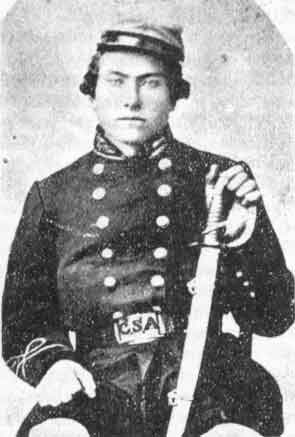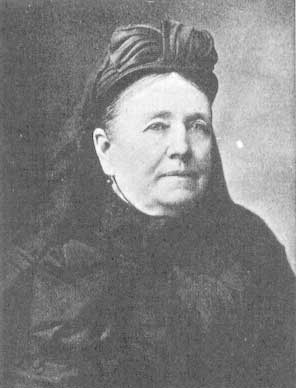|
Patrick Griffin: The Adventure of a Lifetime
By Based on an interview with J. R. Reddig, great-great nephew of Patrick Griffin. Genealogical information was compiled by Barbara Foley Nakaska in 1963. She was Patrick's great-niece, and heard the stories first hand.
Patrick M. Griffin from Nashville was only seventeen-years-old when he joined Rebel
Sons of Erin and left for war. Of that day he recalled, "On that never-to-be-forgotten day when we marched down to the wharf and boarded the steamboat B. M. Runyon I would not have been willing to exchange places with Gen.[Robert E.] Lee."
Patrick Martin Griffin, one of the most colorful
figures to have fought in the Battle of Raymond, was born on St. Patrick's Day,
1844, in County Galway, Ireland. Not only was Patrick named for the patron saint
of Ireland but he was also blessed with the gift of blarney, an Irish term
meaning the gift of gab. During his long lifetime, Patrick used his
uniquely Irish gift to his advantage, and his tales still stir the blood today.
Patrick immigrated to the United States around 1847
with his parents Michael and Honora Griffin. The Potato Famine was at its
height, and in desperation, the little family left three children behind to
travel to the New World. Patrick was only three years old when the sailing ship
David completed an arduous thirteen-week passage of the Atlantic
and docked at the bustling port of Baltimore. Michael found work laying track
for the B & O and L & N Railroads, and followed construction south from Maryland
to the Potomac river port at Alexandria, Virginia. Two years later, the family
followed the rails to the new transportation hub at Nashville, where Michael
continued to swing a hammer for the railroad.
The Griffin family had just begun to live the
American Dream when hard manual labor took its toll. Michael died of
sunstroke on the job, leaving Honora a widow with a young son to raise. Instead
of returning to her family in Ireland, she decided to make Nashville her home
and eventually remarried. As a young teenager, Patrick began to hang around
local Irish pubs and became captivated with the Sons of Erin, a company
of Irish lads who loved military drills, music, whiskey and the Democratic
Party.
Too young to hoist a rifle, Patrick beat the drum as
the lads marched in the park.
In 1861, with the rumblings of war on the horizon,
Patrick begged his mother to let him enlist in the Sons of Erin commanded
by Randal McGavock, a leading figure in Nashville society and the former mayor.
McGavock, a dashing young man, was a graduate of the Harvard Law School, and had
been elected to office in 1858. He had ambitions far beyond the city on the
river, though his prospects were dimmed by the rise of the Republicans, and
decided to cast his lot with the Secessionists. The Sons of Erin flocked
to his side, and Patrick was no exception.
Honora argued that Patrick was too young to enlist,
but the teenager would not be deterred from his desire to go to war behind the
charismatic Lt. Colonel McGavock. In April 1861, with the Sons of Erin
flag flying high, Patrick and the other Irish volunteers left Nashville on the
steamboat B. M. Runyon to join the Confederate Cause.
Patrick's fascination with war soon lost its charm
when the Confederate army, including the 10th Tennessee Irish
Infantry was captured at Fort Donelson. The regiment was sent to Camp Douglas
prison in Chicago where they "wintered it" while waiting for prisoner exchange.
In September 1862, after seven months of confinement, Patrick and the other
prisoners were exchanged and left for Jackson, Mississippi, for the
reorganization of 10th Tennessee.
A year later, May 12, 1863, Patrick was captured
once again, this time during the Battle of Raymond. The days in Raymond were the
most memorable in a life of adventure, and the saddest. Colonel McGavock, his
father-figure and commander, was killed during the final stage of the Battle of
Raymond.
In his memoirs, Patrick recalled the death: "We
had marched up on a rise and were out in the open, and they were in the woods
about one hundred yards in our front when they began to fire on us.... We
had been under fire about twenty minutes, when I heard a ball strike something
behind me. I have a dim remembrance of calling to God. It was my Colonel. H was
about to fall. I caught him and eased him down with his head in the shadow of a
little bush. I knew he was going, and asked him if he had any message for his
mother. His answer was 'Griffin, take care of me! Griffin, take care of me!' I
put my canteen to his lips but he was not conscious. He was shot through the
left breast, and did not live more than five minutes."
Louisa McGavock, the mother of Col. Randal McGavock.
Patrick also recalled how he took McGavock's white
linen handkerchief from his left hip pocket and dipped it in McGavock's blood.
He would give the handkerchief to Louisa McGavock, the colonel's mother. Patrick
also collected his colonel's personal effects: a signet ring, gold watch, and a
few papers; among them was McGavock's journal, with its poignant last entry that
morning.
The Confederates were overwhelmed and Patrick was
again captured by the Yankees. The day after the Battle of Raymond, Patrick was
issued a parole to bury his Colonel in the Raymond cemetery. A wooden coffin was
hastily nailed together and laid tenderly on a bed of a hired wagon for
transport to the local cemetery. Trailing along behind the casket was a ragged
squad of Confederate prisoners and a small gathering of townspeople.
J. R. Reddig, a correspondent for the BBC,
commented on his Uncle Patrick's memoirs of the Battle of Raymond: "I had a
chance to review Patrick's service record at the National Archives a few years
ago, and his story appears based on fact, regardless of the filigree that grew
around it as the years went by. The story of his interaction with Colonel
McGavock's body at Raymond is there, in the spidery handwriting and brown ink of
the time. If the story got better with time, that is only to be expected."
Following the Battle of Raymond and a miraculous
escape from the Yankee captors, Patrick continued his service in the war. After
the fall of Atlanta, he was detailed to be one of General Hood's scouts. A
biographical sketch of Patrick Griffin written in 1902 states, "He was
wounded twice, and was one of three surviving members of the company after the
battle of Peachtree Creek. After the fall of Atlanta, he was detailed to General
Hood's Headquarters Scouts. In sum, he was captured three times: after Ft.
Donelson, after the slaughter in Raymond, and at the end of the war when Hood
turned himself in. Exchanged, escaped, and paroled were how he accounted his
returns. Along the way, he participated in twenty-four general engagements." Patrick Griffin, the proud old Confederate soldier died
on June 5th, 1921 in Nashville at the age of seventy-seven.
Photograph courtesy of Rick and Sheryl Horton, Nashville, TN
After the war, Patrick, age 21, returned to
Nashville and began a civilian life. He married Bridget Welch and had six
children with her, though only three survived infancy. They named one of the
girls Louisa McGavock in memory of Colonel McGavock's mother, Louisa McGavock.
After Bridget's death, he re-married Annie Dean Breene and had two more
children, both sons. Patrick's career was linked to the Nashville, Chattanooga &
St. Louis Railroad in Nashville, where he worked for 52 years.
He built a fine home and became Superintendent of
the Planing Mill for the Nashville-Chattanooga & St. Louis Railroad.
In 1905, Patrick's "gift of gab" led him to submit a
lengthy and delightful article to the Confederate Veteran Magazine in
which he reminisced his war experiences. The stories he recreated were colorful
and essentially truthful - although most likely with a certain amount of
filigree brought about through the passing of time.
J. R. Reddig inherited his Uncle Patrick's gift for
words and story telling. Of his colorful Irish family he writes "I was going
to leave St. Patrick's Day behind this year, but it appears that the Irish are
not done with me just yet. I got an e-mail from Nashville, asking for some
information bout my ancestor who appears in a portrait commissioned for the
history of the Irish regiment that was raised in that city to fight for the
Confederacy. I have seen a copy of the painting, and it is an impressive thing,
with a big gray horse rearing and a proud green banner floating. What I would
really like to see is a family portrait of the dashing young Confederate, his
lovely Irish sister (Barbara) and her husband, a strapping young Yankee teamster.
But that is the root of the story, young people in a wild new land who were
swept away in allegiances to new states and new causes. As for great-great Uncle
Patrick, he is much more of a rogue than I had even expected - or - maybe he was
just a 17-year-old Irish kid off to the greatest adventure of a lifetime."
Patrick Griffin lived through America's hardest
years as a nation in the War Between the States, and saw his son, Walker, march
off to the War with Spain. He saw World War I come and go, and on June 5th, 1921,
the proud old Confederate soldier died at the age of seventy-seven in the house
he built with his own hands.
His daughter Louisa McGavock Griffin, named for the
mother of his beloved Colonel, lived in the house for another thirty years.
Postscript: The
gift of blarney ran in the
family. After the Griffins settled in Nashville, Patrick's sister,
Barbara Griffin, immigrated to America. In 1864, she caught the eye of
Irishman James Foley, who was regimental teamster in the 72nd Ohio
Volunteer Infantry. He had survived Shiloh and Vicksburg, but Barbara
was irresistible. They married while he was on furlough, and his new
Irish bride used her "silver tongue" to persuade James to desert, rather
than return to the fighting. They too lived long lives after the great
war, and kept in touch with Patrick and his family down through the
years. Links The Exploits of Patrick
Griffin: "He Must Have Been Irish"
|


